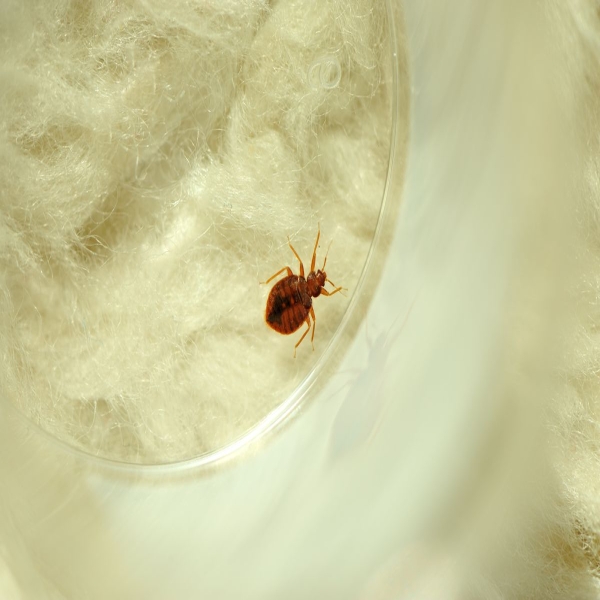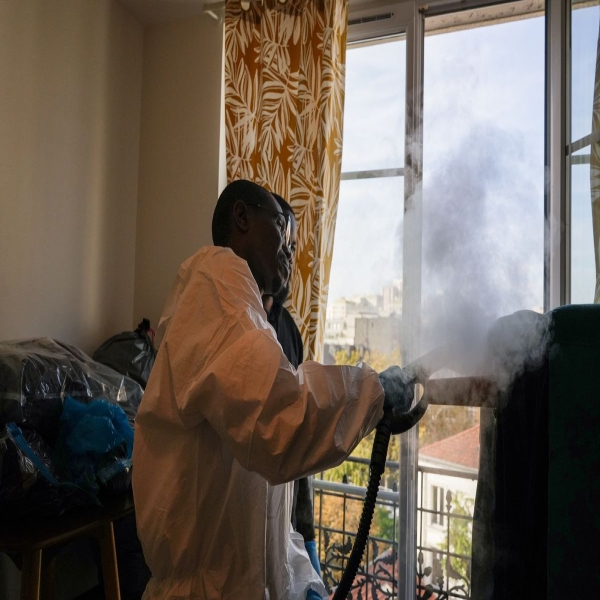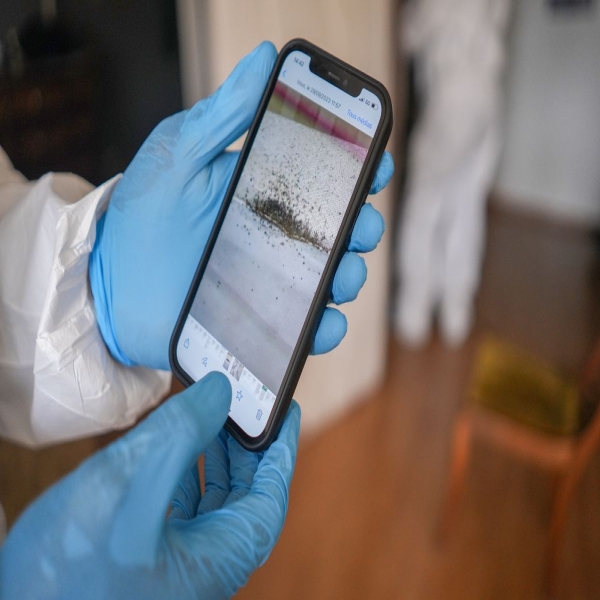It’s a bedbug’s world now. We’re just sleeping in it.

Benji Jones is a senior environmental reporter at Vox, covering biodiversity loss and climate change. Before joining Vox, he was a senior energy reporter at Insider. Benji previously worked as a wildlife researcher.
On a brisk morning last month, the deputy mayor of Paris, Emmanuel Grégoire, stood in front of a French TV camera with a serious look on his face and said: “No one is safe.”
He wasn’t talking about the threat of climate change or some frightening new virus. He was talking about bedbugs.
For the blissfully unaware, bedbugs are small wingless insects that bite humans and feast on our blood, often at night. They find us by sensing the carbon dioxide in our breath and our body heat. While bedbugs can carry a large number of pathogens, they don’t seem to transmit diseases to humans, though they do produce itchy welts.
In recent weeks, viral videos showing insects that look like bedbugs on the Paris metro and trains, and sightings of bedbugs in movie theaters and at the airport, have fueled fears of a widespread outbreak across the city. People have been panicking. “These little insects are spreading despair in our country,” a French politician told Parliament earlier this month, urging the prime minister to act. (She brought a vial of bed bugs with her into the chamber, presumably in an effort to strengthen her point.)

Elevating these concerns is the looming Summer Olympics, which will take place in Paris just 10 months from now. Millions of people will descend on Paris for the Games. And you know what likes millions of people? Bedbugs.
The extent of the current “outbreak” isn’t clear, and most of the sightings have not been confirmed. Videos, news reports, and memes have almost certainly made the problem seem far bigger than it really is (go figure!).
But this isn’t exactly good news. Paris certainly does have bed bugs. So does Chicago, New York, and every other major city in the world. These bloodsuckers are, unfortunately, everywhere.
It gets worse: Over the last two decades, there’s been a “global resurgence” in bedbugs, according to a recent scientific review, following lows in the mid-20th century. “The resurgence has been widespread, affecting virtually every sector of society,” the authors wrote.
Scientists say this surge is unlikely to wane anytime soon. So for now, it’s a bedbug’s world. Welcome.
The rise and fall and rise of bedbugs
No matter how potent the threat of bedbugs may feel today, I promise that it used to be worse. These insects have been gorging on our legs and arms and crotches for thousands of years, dating back to ancient Egypt — long before the invention of chemical pesticides.
In the 1800s, some London hotels were so infested that lodgers “were advised to become half-drunk to obtain some sleep,” according to the recent scientific review. Entire buildings would be burned down in order to stamp out an infestation. It was the golden age of bedbugs (at least from the perspective of a bedbug).
The tables turned in the 1940s, when the chemical DDT was popularized as an insecticide. During World War II, militaries sprayed DDT to control mosquito-borne diseases, such as malaria, as well as body lice. It was also shown to be highly effective at killing bedbugs. Along with other newly developed pesticides, DDT helped wipe out bedbug populations. By the 1960s, bedbug infestations were rare, at least among wealthy nations, according to the review.
For the next few decades, citizens in the US and Europe enjoyed evenings largely free of bedbug bites, even after DDT was banned in the US in 1972 (for its harmful impacts on humans and wildlife). But the reprieve obviously didn’t last.

Around the turn of the century, the parasites began reentering people’s homes and beds in droves, according to reports from the UK, US, Australia, Japan, and a handful of other countries. In Australia, for example, infestations of bed bugs rose by an estimated 4,500 percent between 1999 and 2006. There isn’t clear data on the number of infestations in the US, though in 2010 the Centers for Disease Control and Prevention and the Environmental Protection Agency issued a joint statement, warning of an “alarming resurgence” of these pests.
That brings us to today. Bedbugs are back. Why?
Why bed bugs are surging now
There are some obvious reasons. More people live in cities now, and bedbugs love densely packed warm bodies. We’re also traveling more than ever before, giving bedbugs an opportunity to spread (see: horror stories of bedbugs in Airbnbs).
But the main reason why it’s boom time for bedbugs, according to the review, is that they’ve evolved resistance to many pesticides, our main line of defense. Indeed, these critters are now resistant to “most of the major classes of insecticides,” the review states, including pyrethroids, which is still one of the most commonly used insecticides. They’ve also developed resistance to DDT, which attacks insects in a similar way to pyrethroids.
“Insecticides, especially the use of pyrethroids, are useless,” said Chow-Yang Lee, a professor of urban entomology at the University of California Riverside and a co-author of the recent review. “That will never get rid of bedbugs.”
There’s also some evidence that powders like diatomaceous earth — which is designed to kill the bugs by drying them out — no longer work either. At least some of the insects have evolved resistance to desiccation, Lee said.
That doesn’t mean bedbugs are impossible to destroy. High temperatures, around 113 degrees Fahrenheit and above, kill the insects, and research suggests that they aren’t likely to evolve heat tolerance. So do extremely cold temperatures. Fumigation using highly toxic chemicals and insecticide combinations can work too, Lee said, especially when they’re used repeatedly.

But these effective options come with a very important caveat: They’re expensive.
Low-income communities often can’t afford these eradication methods, Lee said, which can cost several hundred to thousands of dollars for a single apartment. Large complexes might hire an exterminator, but he or she may only spend a few minutes in each unit spraying chemicals that don’t work, he said.
These communities may also be home to elderly folks who can’t easily vacate their apartments for treatment; the exterminator has to work around them, so they’ll undoubtedly miss some spots. These less-affluent communities are considered reservoirs that can spread bedbugs throughout a city, Lee said.
“The biggest challenge when it comes to treating bedbugs is cost,” Lee said.
How to avoid bedbugs
While it’s hard to eradicate bedbugs, it’s relatively easy to avoid them.
Here’s a tip: When you enter a hotel or Airbnb, immediately check the mattress for reddish-brown blood stains, Lee said. After bed bugs feast, he said, they defecate, and their poop includes some staining hemoglobin (sorry). You can also look for the bugs themselves, which are visible to the naked eye; they’re roughly the size of an apple seed.
Let’s say you do end up staying somewhere with bedbugs. When you get back home, Lee said, don’t bring your luggage inside. Take out your clothes and put them in the dryer for at least 30 minutes (or wash them and then dry them). Then, use a garment steamer to heat-treat your luggage outside. That should kill any eggs.

Now let’s say you’ve found them in your home. Immediately call for professional help, Lee said. “Do not attempt to treat it yourself,” he said. If the infestation is small, an exterminator may treat your bed or furniture with a hand-held steamer, though if they’re everywhere, the exterminator may want to fumigate or place your furniture into a heat chamber — that’s when the costs will go up.
Finally, a word from Lee for all of you thrifters: Be very wary about taking anything off the street, especially in cities like New York and Chicago. If you plan to take in any furniture — especially sofas, chairs, beds, and mattresses — you should have it heated first.
Books, too, should be treated. “Do not bring them directly into the house,” Lee said. If it’s the middle of summer or winter, you can leave the books outside for a day or two — the heat or cold will force the bedbugs out or kill them. Or you can simply put them in a sealed plastic bag and place them in your freezer for a few days.
These solutions will help you avoid bites or a home invasion. Yet until cheaper effective options are available — or the cost of heat treatment is subsidized for low-income communities — it’s unlikely the bedbug problem in the US and elsewhere will be eliminated. According to the EPA, “financial assistance [for bedbug treatment] is not generally available.”
In the meantime, we’ll have to learn to live with the threat of bedbugs.
“We have not seen the light at the end of the tunnel,” Lee said. “Until we come out with some method that is affordable to everyone, we will remain in the tunnel.”
Source: vox.com






